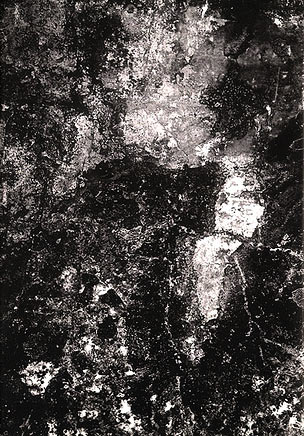Review: Chizu (The Map) by Kikuji Kawada
 As humanity’s technological abilities expanded over the course of the 20th Century, its willingness to slaughter large numbers of its own members remained the same. Developing new means of mass slaughter out of new technologies - where those new technologies were not in fact the sole purpose of such slaughter - has kept legions of scientists busy; and for almost every technology there has been a sinister application. For each and every one of those applications there have been enough people to find ways to justify their use so that what could potentially be used to killed tens or even hundreds of thousands of people in no time actually was employed for that very purpose. Artists have struggled to comprehend what was and still is actually happening - to give a voice to those who perished, to understand why humans have so eagerly embraced the technologies made possible by enlightenment, but so vigorously rejected the “categorical imperative” that was supposed to be part of enlightenment.
As humanity’s technological abilities expanded over the course of the 20th Century, its willingness to slaughter large numbers of its own members remained the same. Developing new means of mass slaughter out of new technologies - where those new technologies were not in fact the sole purpose of such slaughter - has kept legions of scientists busy; and for almost every technology there has been a sinister application. For each and every one of those applications there have been enough people to find ways to justify their use so that what could potentially be used to killed tens or even hundreds of thousands of people in no time actually was employed for that very purpose. Artists have struggled to comprehend what was and still is actually happening - to give a voice to those who perished, to understand why humans have so eagerly embraced the technologies made possible by enlightenment, but so vigorously rejected the “categorical imperative” that was supposed to be part of enlightenment.
How does one comprehend thousands and thousands of people perishing? There is almost no way that words could be used for such an endeavour. The abyss we’re staring into in such a situation is complete: Nothing will ever be able to convey what the deaths of thousands and thousands of people really mean. Of course, this doesn’t mean that we can’t try to comprehend.
Kikuji Kawada’s Chizu (The Map), originally published in 1965, 20 years after an atomic bomb destroyed Hiroshima, and re-published by Nazraeli Press in 2005, has been rightly called one of the most important photography books ever produced. Parr and Badger’s “The Photobook: A History, Vol. I” described it as “a masterly amalgam of abstraction and realism, of the specific and the ineffable, woven into a tapestry that makes the act of reading them a process of re-creation in itself.” The central idea of a map is a metaphor - it refers to photographs of the walls of Hiroshima’s formerly Prefectural Commercial Exhibition Hall, now a memorial, which stood right underneath the spot where the atomic bomb exploded. You can - and you will - read into those maps whatever your mind creates; the possibilities are endless.
It’s a triumph of photography, which moves way beyond what people think of as “depicting the facts” and which fully shows its power as an art form. As “The Photobook I” notes, there are abstract “maps”, and there are photographs of objects - connecting what is abstract, to be filled with meaning, with the lives or people; and all that in a heavy b/w. Perfect.
Chizu (The Map) will cost you some money, which is not all that surprising since it was printed in a small (500) edition (thus ensuring it would be costly). I got my copy on Ebay.